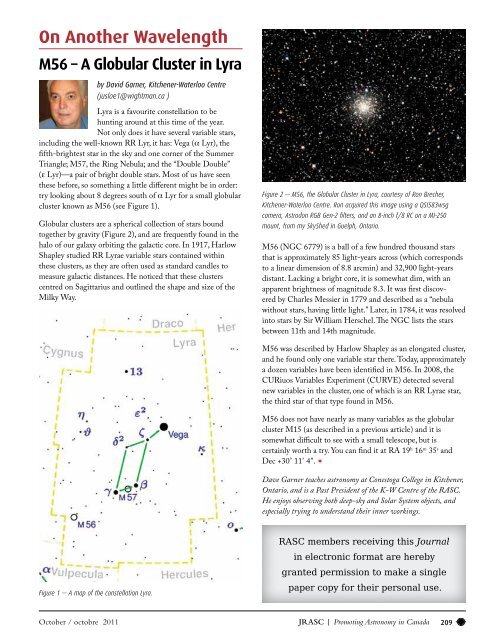The stunning Orion Nebula - The Royal Astronomical Society of ...
The stunning Orion Nebula - The Royal Astronomical Society of ...
The stunning Orion Nebula - The Royal Astronomical Society of ...
Create successful ePaper yourself
Turn your PDF publications into a flip-book with our unique Google optimized e-Paper software.
On Another Wavelength<br />
M56 – A Globular Cluster in Lyra<br />
by David Garner, Kitchener-Waterloo Centre<br />
(jusloe1@wightman.ca )<br />
Lyra is a favourite constellation to be<br />
hunting around at this time <strong>of</strong> the year.<br />
Not only does it have several variable stars,<br />
including the well-known RR Lyr, it has: Vega (α Lyr), the<br />
fifth-brightest star in the sky and one corner <strong>of</strong> the Summer<br />
Triangle; M57, the Ring <strong>Nebula</strong>; and the “Double Double”<br />
(ε Lyr)—a pair <strong>of</strong> bright double stars. Most <strong>of</strong> us have seen<br />
these before, so something a little different might be in order:<br />
try looking about 8 degrees south <strong>of</strong> α Lyr for a small globular<br />
cluster known as M56 (see Figure 1).<br />
Globular clusters are a spherical collection <strong>of</strong> stars bound<br />
together by gravity (Figure 2), and are frequently found in the<br />
halo <strong>of</strong> our galaxy orbiting the galactic core. In 1917, Harlow<br />
Shapley studied RR Lyrae variable stars contained within<br />
these clusters, as they are <strong>of</strong>ten used as standard candles to<br />
measure galactic distances. He noticed that these clusters<br />
centred on Sagittarius and outlined the shape and size <strong>of</strong> the<br />
Milky Way.<br />
Figure 1 — A map <strong>of</strong> the constellation Lyra.<br />
Figure 2 — M56, the Globular Cluster in Lyra, courtesy <strong>of</strong> Ron Brecher,<br />
Kitchener-Waterloo Centre. Ron acquired this image using a QSI583wsg<br />
camera, Astrodon RGB Gen-2 filters, and an 8-inch f/8 RC on a MI-250<br />
mount, from my SkyShed in Guelph, Ontario.<br />
M56 (NGC 6779) is a ball <strong>of</strong> a few hundred thousand stars<br />
that is approximately 85 light-years across (which corresponds<br />
to a linear dimension <strong>of</strong> 8.8 arcmin) and 32,900 light-years<br />
distant. Lacking a bright core, it is somewhat dim, with an<br />
apparent brightness <strong>of</strong> magnitude 8.3. It was first discovered<br />
by Charles Messier in 1779 and described as a “nebula<br />
without stars, having little light.” Later, in 1784, it was resolved<br />
into stars by Sir William Herschel. <strong>The</strong> NGC lists the stars<br />
between 11th and 14th magnitude.<br />
M56 was described by Harlow Shapley as an elongated cluster,<br />
and he found only one variable star there. Today, approximately<br />
a dozen variables have been identified in M56. In 2008, the<br />
CURiuos Variables Experiment (CURVE) detected several<br />
new variables in the cluster, one <strong>of</strong> which is an RR Lyrae star,<br />
the third star <strong>of</strong> that type found in M56.<br />
M56 does not have nearly as many variables as the globular<br />
cluster M15 (as described in a previous article) and it is<br />
somewhat difficult to see with a small telescope, but is<br />
certainly worth a try. You can find it at RA 19 h 16 m 35 s and<br />
Dec +30° 11′ 4″. V<br />
Dave Garner teaches astronomy at Conestoga College in Kitchener,<br />
Ontario, and is a Past President <strong>of</strong> the K-W Centre <strong>of</strong> the RASC.<br />
He enjoys observing both deep-sky and Solar System objects, and<br />
especially trying to understand their inner workings.<br />
RASC members receiving this Journal<br />
in electronic format are hereby<br />
granted permission to make a single<br />
paper copy for their personal use.<br />
October / octobre 2011 JRASC | Promoting Astronomy in Canada<br />
209

















